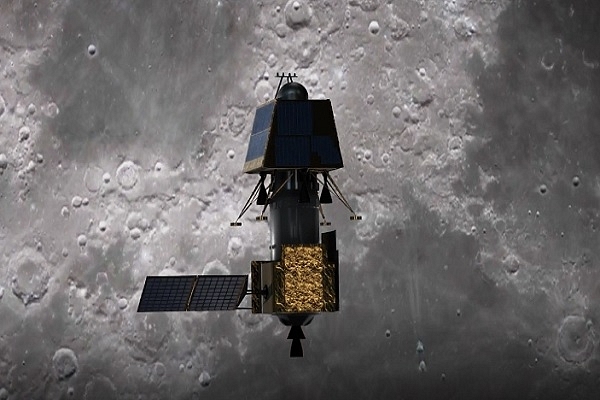Insta
ISRO Releases Pictures Of Impact Craters On Moon Surface Taken By Chandrayaan-2’s Orbiter

ISRO’s Chandrayaan-2 (Representative Image) (Pic Via ISRO’s Website)
Indian space agency has released fresh set of pictures of impact craters on moon surface taken by its Chandrayaan-2 Orbiter.
The Indian Space Research Organisation (ISRO) on Tuesday (22 October) releasing a picture on its Twitter handle said the images were taken by the Dual Frequency-Synthetic Aperture Radar (DF-SAR) on its Chandrayaan-2 Orbiter.
Impact craters are approximately circular depressions on the surface of the moon, ranging from small, simple, bowl-shaped depressions to large, complex, multi-ringed impact basins.
"In contrast to volcanic craters, which result from explosion or internal collapse, impact craters typically have raised rims and floors that are lower in elevation than the surrounding terrain," ISRO said.
According to ISRO, weathering processes result in many of the crater physical features and ejecta material get covered by layers of regolith (sand, dust, loose rock and soil over a hard surface) making some of them undetectable using optical cameras.
ISRO said that L&S band SAR on Chandraayan-2 is designed to produce greater details about the morphology and ejecta materials of impact craters due to its ability of imaging with higher resolution (2 - 75m slant range) and full-polarimetric modes in standalone as well as joint modes in S and L-band with wide range of incidence angle coverage (9.5 degrees - 35 degrees).
In addition, the greater depth of penetration of L-band (3-5 meters) enables probing the buried terrain at greater depths.
"Chandrayaan-2 Orbiter's DF- SAR has been operated in full-polarimetry mode- a gold standard in SAR polarimetry, and is the first-ever by any planetary SAR instrument," ISRO said.
This image presents many interesting facts about the secondary craters of different ages and origins in the lunar south polar region, the space agency said.
"The yellowish tone around crater rims in the image shows ejecta fields. The distribution of ejecta fields, whether uniformly distributed in all directions or oriented towards a particular side of a crater, indicates the nature of the impact," ISRO explained.
According to ISRO, the image shows craters of vertical impact and oblique impact on the top-right and bottom-right, respectively.
Three similar sized craters along a row on the bottom-right of the image show examples of young crater, moderately weathered crater and an old degraded crater.
Many of the ejecta fields seen in the image are not visible in high-resolution optical image over the same region, indicating the ejecta fields are buried beneath regolith layers.
(With inputs from IANS)
Support Swarajya's 50 Ground Reports Project & Sponsor A Story
Every general election Swarajya does a 50 ground reports project.
Aimed only at serious readers and those who appreciate the nuances of political undercurrents, the project provides a sense of India's electoral landscape. As you know, these reports are produced after considerable investment of travel, time and effort on the ground.
This time too we've kicked off the project in style and have covered over 30 constituencies already. If you're someone who appreciates such work and have enjoyed our coverage please consider sponsoring a ground report for just Rs 2999 to Rs 19,999 - it goes a long way in helping us produce more quality reportage.
You can also back this project by becoming a subscriber for as little as Rs 999 - so do click on this links and choose a plan that suits you and back us.
Click below to contribute.
Latest